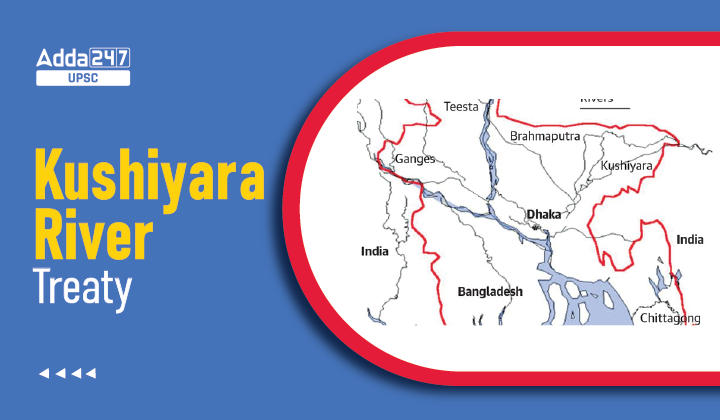Table of Contents
Kushiyara River Treaty- Relevance for UPSC Exam
General Studies II- India and its Neighborhood.
In News
For the first time in 26 years, India and Bangladesh agreed to share the waters of a significant transboundary river, the Kushiyara, while negotiations over a long-delayed agreement to share the Teesta River’s waters, which are politically sensitive are still ongoing.
India-Bangla water disputes
- The Teesta River and the Ganges River dispute are the two main long-standing water conflicts between India and Bangladesh.
- Both rivers are important supplies of water for fishermen, farmers, and boatmen in both nations.
- Since the sacred river flows from India to Bangladesh, the Ganga River dispute has been a source of contention between the two countries for the past 35 years.
- There hasn’t been a long-term solution for sharing water offered despite several rounds of bilateral negotiations failing.
- In order to establish a water sharing arrangement for the following 30 years, a treaty was signed in 1996 which is about to expire.
The Kushiyara River Treaty
- The first such deal since the 1996 signing of the Ganga water treaty, India and Bangladesh reached an interim agreement on water sharing for the Kushiyara River.
- India withdrew its objection to withdrawal of Kushiyara’s waters by Bangladesh through the Rahimpur Canal.
- Over the last century, the flow of the Barak River has changed in such a way that the bulk of the river’s water flows into Kushiyara while the rest goes into Surma.
- The agreement is aimed at addressing part of the problem that the changing nature of the river has posed before Bangladesh as it unleashes floods during the monsoon.
- It goes dry during the winter when demand of water goes up because of a crop cycle in Sylhet.
Terms of the treaty
- Under this MoU, Bangladesh will be able to withdraw 153 cusecs (cubic feet per second) of water from the Kushiyara out of the approximately 2,500 cusecs of water that is there in the river during the winter season.
- The agreement addresses Bangladesh’s concern over water supply along the river, during the winter months but flood control in the basin of Kushiyara is expected to require much more work.
Benefits to Bangladesh
- The water of Kushiyara will be channelled through the Rahimpur Canal project in Sylhet.
- The eight km long canal is the only supplier of water from the Kushiyara to the region and Bangladesh has built a pump house and other facilities for withdrawal of water that can now be utilised.
- It is generally understood that approximately 10,000 hectares of land and millions of people will benefit from the water that will flow through a network of canals in Sylhet.
- It will benefit the farmers involved in Boro rice, which is basically the rice cultivated during the dry season of December to February and harvested in early summer.
- Bangladesh has been complaining that the Boro rice cultivation in the region had been suffering as India did not allow it to withdraw the required water from the Kushiyara.
Why is the water from the Kushiyara so important for Rahimpur Canal?
- The water of the Kushiyara has been used for centuries in Sylhet’s subdivisions like the Zakiganj, Kanaighat and Beanibazar areas.
- But Bangladesh has witnessed that the flow and volume of water in the canal has reduced during the lean season.
- The utility of the river and the canal during the lean/winter season had gone down, affecting cultivation of rice as well as a wide variety of vegetables for which Sylhet is famous.
India’s objection to the Rahimpur Canal
- India objected to the clearing and dredging of canal.
- It claimed that the dyke and other infrastructure interfered in border security as Kushiyara itself forms part of the border between the two sides.
- However, the agreement indicates that the economic benefits possible from the river outweighed the security
Hurdles to the Teesta agreement
- The Kushiyara agreement is relatively smaller in scale in comparison to Teesta that involves West Bengal, which has problems with the proposal.
- The Kushiyara agreement did not require a nod from any of the States like Assam from which the Barak emerges and branches into Kushiyara and Surma.




 TSPSC Group 1 Question Paper 2024, Downl...
TSPSC Group 1 Question Paper 2024, Downl...
 TSPSC Group 1 Answer key 2024 Out, Downl...
TSPSC Group 1 Answer key 2024 Out, Downl...
 UPSC Prelims 2024 Question Paper, Downlo...
UPSC Prelims 2024 Question Paper, Downlo...
